
Kuban Cavalry
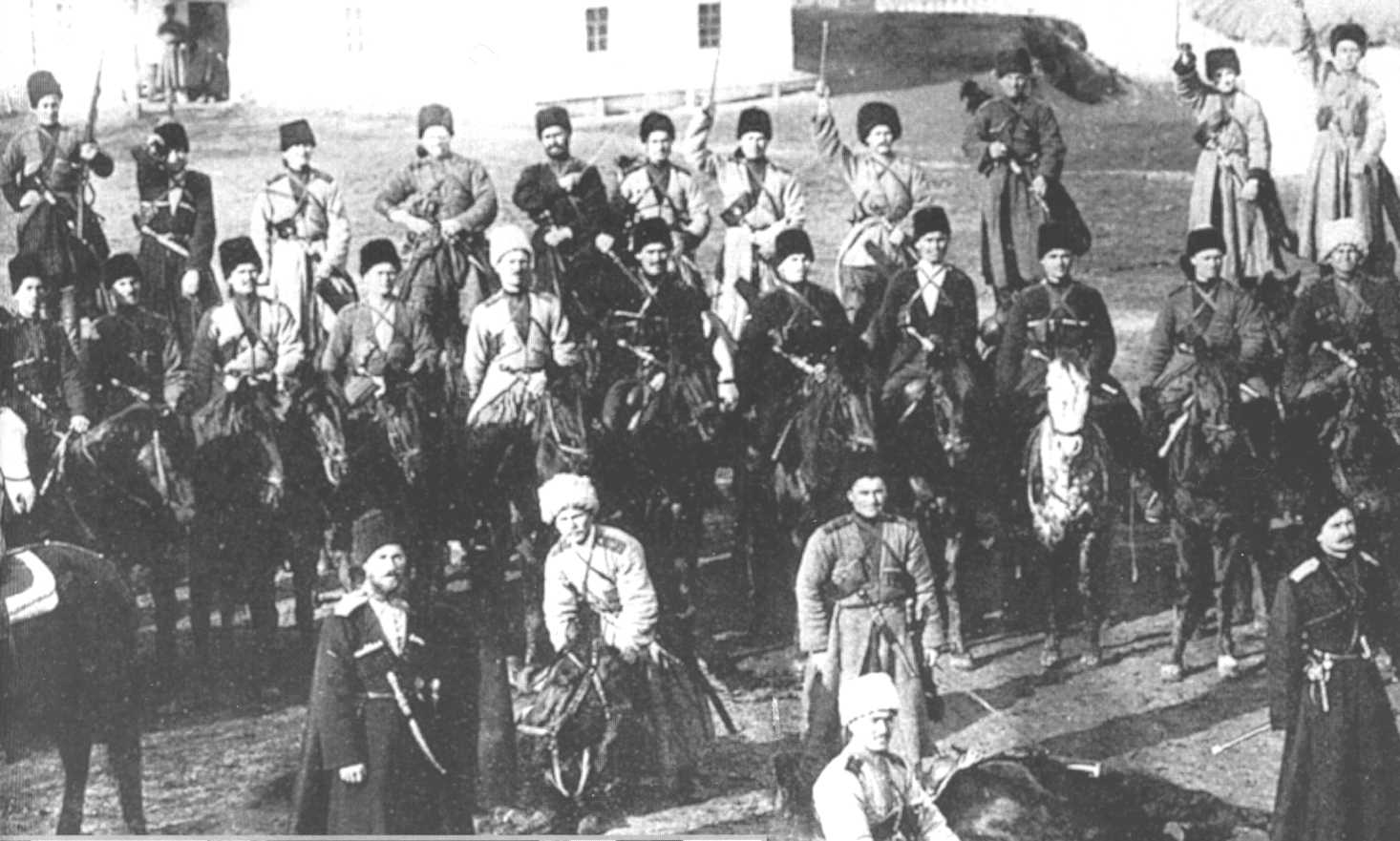
Kuban Cossacks in the Civil War, showing the variety of colour of cherkeskas and beshmets worn.
While the Kuban supplied a few plastoon units, like all Cossacks the majority preferred to fight on horseback.
This page covers the main regiments of the Kuban Host. Some special units also recruited from Kuban Cossacks in the RCW are are the Kornilov Horse and Shkuro's Wolves.
1stZaporozhian Regiment of the Kuban Host
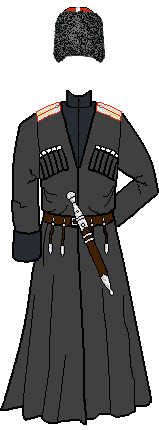 |
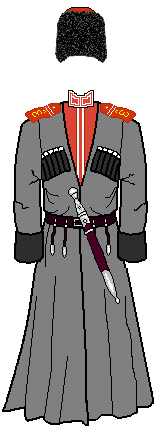 |
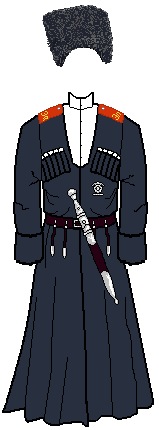 |
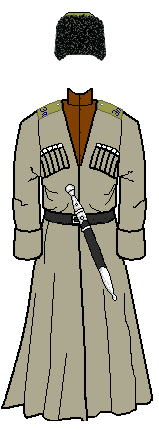 |
| Esau (Captain): 1st Zaporozhian Regt | Sergeant: 1st Zaporozhian Regt Imperial monogram | Trooper: Zaporozhian Divizion non-Tsarist cipher 1920 | Trooper: Zaporozhian Divizion non-Tsarist cipher 1920 |
The Kuban Host colour was red, and it appears all units of the Kuban Host used it, although the exact shade varied greatly.
We have seen it suggested that the Kuban Cossacks favoured pale grey cherkeskas. If they did, then it certainly was not to the exclusion of other colours.
Officially it seems that the beshmet shirt was be red trimmed with lace along the collar and front. In the field plain shirts were very much the norm.
Uniform Details
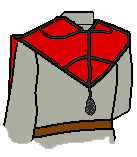 |
 |
 |
| Kuban Bashlyk: Host red, with possible black trim | Kuban cavalry hats, with the cross for officers and plain for men | Shoulderboards of the 1st Zaporozhian Regiment in WWI. |
The Imperial 1st Zaporozhian Regiment of the Kuban Cossack Host was named in honour of Tsarina Ekaterina II (more commonly known in English as Catherine the Great), and bore her monogram of an E with a II through it.
Dress shoulderboards were red, with yellow stencilling. The field versions were khaki with the monogram in dark blue.
Buttons and lace were silver. As cavalry, officers metal or bullion monograms were reversed to be in gold.
Crowns of papakhi (fur hats) might have coloured tops as shown, or plain khaki in the field. Few men seem to have worn cockades.
History in the RCW
The 1st Zaporozhian Regiment was reformed in the Volunteer Army in July 1918 in the 1st Cavalry Division. When the Kuban Host Army was formed it went into its 1st Horse Division, being one of the "senior" regiments. However that doesn't mean it was always very large: in October 1919 it had only 58 sabres and 2 MGs. After the retreat to the Kuban and surrender of the Kuban Army the regiment was disbanded.
An Independent Zaporozhian Kuban Cossack Horse Divizion was reformed by Wrangel in the Crimea, presumably the 1st Squadron at least being the remnants of the 1st Zaporozhian Regiment. It fought as the divisional cavalry of the reformed 7th Infantry Division (alongside the 1st Partisan "General Alekseev" Infantry Regiment, Terek Plastoon Cossack Regiment, 1st and 2nd Kuban Rifle Regiments, the 7th Artillery Brigade and a Independent Kuban Engineer Sotnia).
Flags
All the Kuban ceremonial flags were spirited out of Russia during the Civil War, so it seem unlikely that any units fought under Nikolai or St George flags, unless they used replicas.
The actual field banner of a Kuban regimental commander was a square banner in Host red with a distinguishing number or sign, such as that shown on the left below. That's a bit dull, and we also doubt White units fought under such confusingly red flags, so an option with the monogram on the Kuban Army banner is given as an alternative on the right.

Sotnia (i.e. squadron) flags had the regimental number or monogram, with Host colours above and squadron colours below. Below are the the official sotnia flags for the 1st Zaporozhian Regiment's first and second squadrons:

The sotnia colours were: scarlet, light blue, white, dark green, yellow and brown respectively.
Other Similar Units
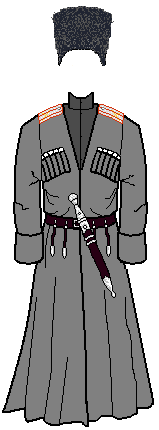 |
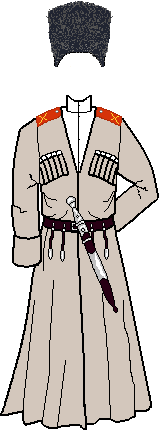 |
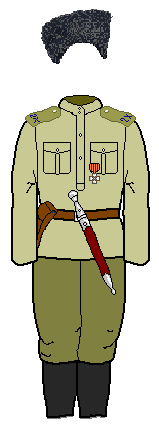 |
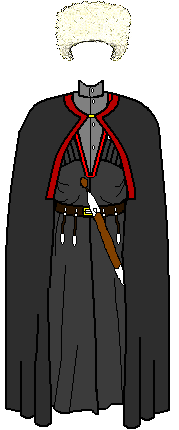 |
| Colonel: Kuban Host | Private: Khoper Regt 1913 or Composite Diviz. 1920 | Trooper: 2nd Khoper Regt in alternative service dress | Trooper: Kuban Host in cold weather kit with burka |
Apart from those regiments we have shown with separate pages, the shoulderboard ciphers are the only difference in uniforms between the other Kuban Cavalry of WWI and the Civil War.
Other monograms
These are the Imperial monograms for the other pre-WWI Kuban regiments:

Khoper, Taman, Poltava, Ekaterinodar, Kuban, Black Sea (Chernomorsk), Caucasus, Uman, Zaporozhian, Line and Labinsk Regiment monograms, respectively.
In wartime, as the reserve 2nd and 3rd units of each was drafted they added the unit number in front, so there would be 1 Зп, 2 Зп and 3 Зп for the three Zaporozhian Regiment.
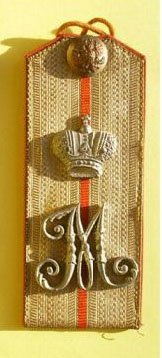 The 1st Kuban Cossack Regiment, 1st Kuban Plastoon battalion and 1st Kuban Artillery Battery were awarded a special monogram in 1912, when they were named in honour of Grand Duke Mikhail Nikolayevich, great uncle to Nikolai II and Governor of Caucasia for 20 years.
The 1st Kuban Cossack Regiment, 1st Kuban Plastoon battalion and 1st Kuban Artillery Battery were awarded a special monogram in 1912, when they were named in honour of Grand Duke Mikhail Nikolayevich, great uncle to Nikolai II and Governor of Caucasia for 20 years.
An example can be seen to the left. This would seem to be the shoulderboard of a captain of the 1st Kuban Plastoon Battalion as Kuban cavalry had silver lace and artillery would also have the crossed cannons of that arm.
Such obviously Romanov symbols may or may not have been worn in the Civil War.
Most of the Kuban Cossack units of the Imperial army were reformed in the Civil War, which led to most of them being quite small. All the pre-war regiments had at least a 1st and 2nd Regiment reformed, with the 3rd Uman, Black Sea, Caucasus, Zaporozhian and (briefly) Kuban Regiments appearing as well.
There were also three Composite Kuban Regiments and the 1st and 2nd Partisan Kuban Regiments, but we do not know the cipher for these (if indeed they had one).
Unit histories
Kuban Cossack units were formed as the Volunteer Army cleared the Host area in early 1918, sometimes by the VA recruiting and sometimes as it swept up former partisans. In June/July there was a reorganisation and most of the 1st and 2nd Regiments were numbered. After freeing the Caucasus the bulk of them were moved into the Caucasian Army under Baron Wrangel, though a division was briefly attached to the Don Army and single regiments with the Volunteer Army.
With the total collapse of the Kuban Host in mid-1920, all these units basically disappeared (except the 2nd Labinsk Regiment which went with Bredov to Poland). Baron Wrangel could only assemble one division of Kuban Cavalry for the Crimean breakout:
1st Kuban Cossack Division – Major-General Babiev – 1,000-1,500 sabres.
Kornilov Horse Regiment
1st Labinsk Cossack Regiment
1st Line Cossack Regiment
1st Uman Cossack Regiment
Kuban Composite Divizion
1st Kuban Cossack Horse-Artillery Divizion
2nd Horse Artillery Divizion
There was also the Zaporozhian Divizion with the 7th Infantry Division, as noted above, and Shkuro's Kuban "Wolves" Divizion was somewhere (likely also attached to this division in fact).
Other flags
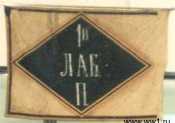 A 1st Labinsk Regiment flag has survived the war and is in a Russian museum. It has an abbreviated name – 1й Лаб П – in a dark diamond on a red background (often shown as yellow in illustrations, but probably faded red, since that is the Host colour). This is our rendition:
A 1st Labinsk Regiment flag has survived the war and is in a Russian museum. It has an abbreviated name – 1й Лаб П – in a dark diamond on a red background (often shown as yellow in illustrations, but probably faded red, since that is the Host colour). This is our rendition:
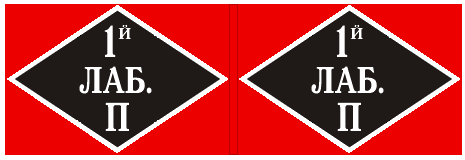
Mamontov says that the 1st Ekaterinodar Regiment's flag was sky blue. With these in mind, it seems reasonable to use a mix of Imperial and Civil War themes when drawing flags, since they obviously branched out a bit.
This is a variant for the 1st Uman Cossack Regiment's staff flag, based on the standard Imperial form of a red diamond in blue for Cossack regimental staff:
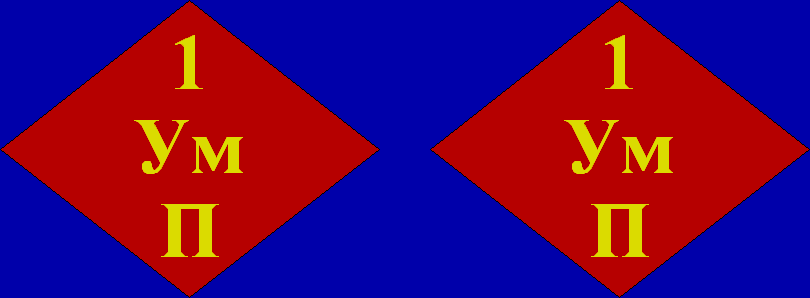
This a variant on the 2nd Kuban Cossack Regiment battle flag, where a distinguishing strip in the national colours is sewn to the WWI version.
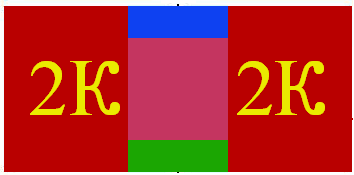
As noted, the Kuban ceremonial flags were spirited out of Russia so were unavailable for units, but for those of you looking for WWI or earliers flags, the 2nd and 3rd Zaporozhian Regiment were granted ones like this in 1853.
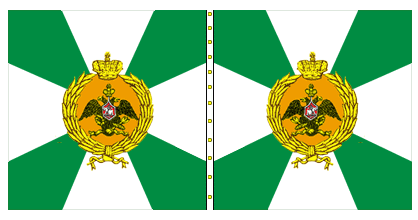 source: vellixographia
source: vellixographia
And the three Khoper Regiments had ones like this from 1896
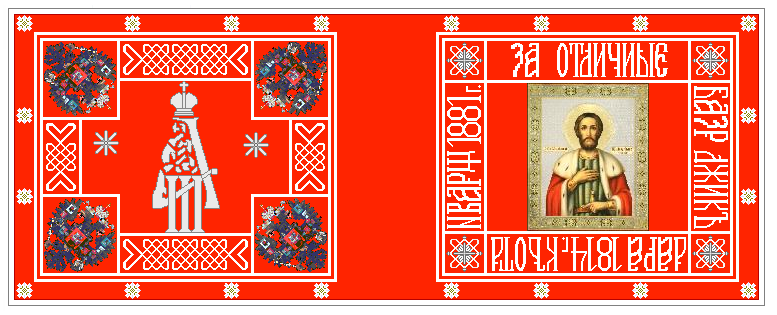
Photos
We have collected various period photos of Kuban Cossacks on a separate page.